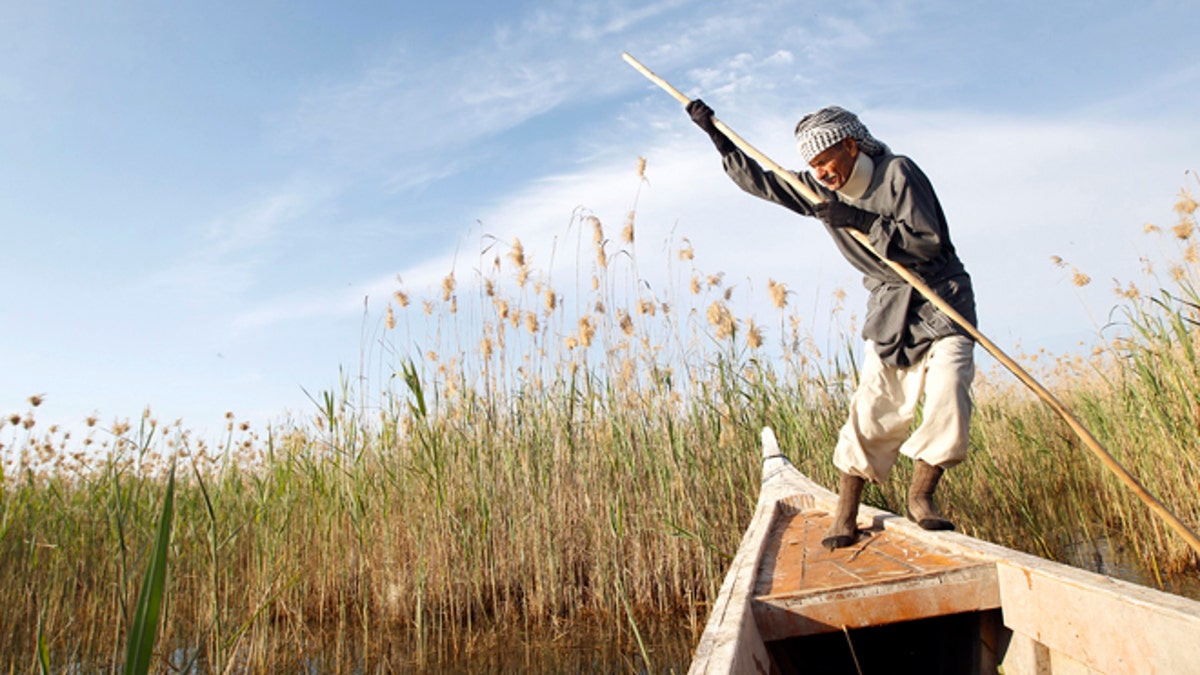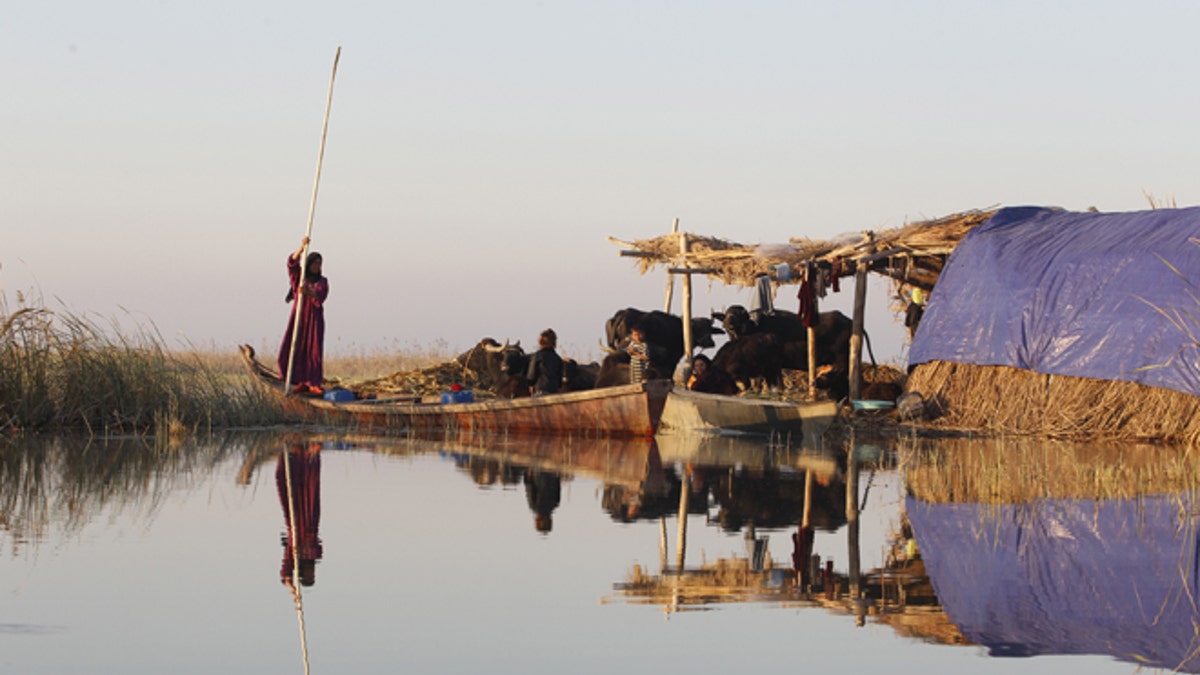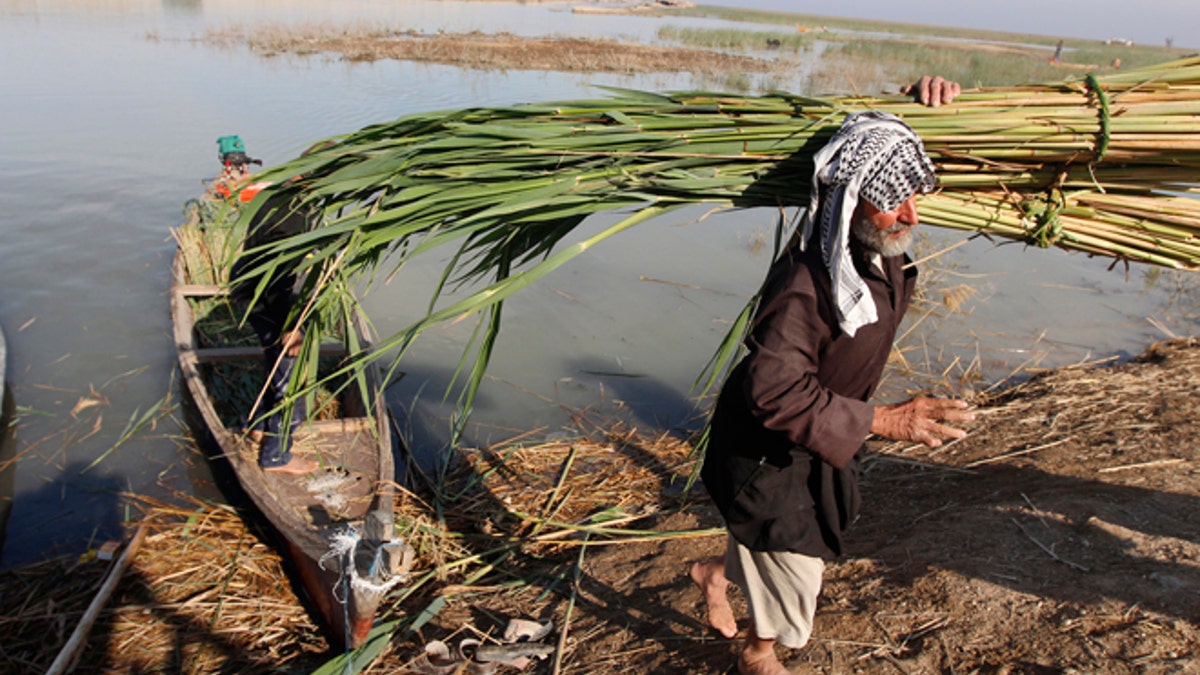
Marsh Arab Abu Sabah paddles his boat at the Chebayesh marsh in Nassiriya, 300 km (185 miles) southeast of Baghdad. (Reuters)
For more than 6,000 years, the marshlands of southern Iraq played a major role in sustaining the agriculture, economies and livelihoods of those residing in the Fertile Crescent.
Living in arched reed houses and relying on water buffalo along with rice, barley, wheat and pearl millet for sustenance, the inhabitants of these wetlands – the so-called Marsh Arabs – maintained for centuries a lifestyle that was both unique and separate from the rest of the Middle East.
But things changed rapidly in 1992, when former Iraqi dictator Saddam Hussein – angered by claims that the Marsh Arabs were harboring defeated Shia rebels – decided to punish them by sending engineers to divert the Tigris and Euphrates rivers away from the marshes. The billion dollar retaliation project was disastrous – turning the almost 20,000-square-miles of marsh into a virtual desert and displacing the half million people who called the region home.
Now with Hussein dead and a tenuous Iraqi government attempting to bring some semblance of peace to the turbulent nation, officials in Baghdad – along with scientists from the United States – are working to revive what was once the Middle East’s largest wetlands and help the Marsh Arabs return to their ancestral homeland.
“These are our marshes, they’re a key part of our heritage, and we’re doing everything we can to get the water to them to preserve them,” Hassan Janabi, Iraq’s minister of water resources told the Guardian. Last July, UNESCO designated Iraq's marshes as a world heritage site.

An Iraqi Marsh Arab woman paddles her boat at the Chebayesh marsh in Nassiriya, 300 km (185 miles) southeast of Baghdad. (Reuters)
Restoring the wetlands, however, is not as simple as just breaking up the dams and dikes and flooding the area.
“After the U.S. invasion in 2003, a lot of people tried to knock down the dams and dikes,” Jennifer Pournelle, a professor at the University of South Carolina who has spent the majority of her academic career studying the ancient civilizations that once thrived along Iraq’s southern marshes, told Fox News. “But when you drain a marsh, you can’t just put water back in because you just get muck.”
Since the marshland was destroyed in the early 1990s, numerous dams have been built on both the Tigris and Euphrates rivers to irrigate land not just in Iraq but in neighboring Turkey and Syria. Turkey alone has built at least 34 large dams on the Euphrates and Tigris and their tributaries.
While these dams have no doubt helped farmers in drier northern Iraq, they have also prevented the flood pulse from the Taurus and Zagros mountains from flushing out the marshland – leaving only stagnant water in the remaining parts of the region.
Adding to this quagmire is that earlier efforts to refill the wetlands used waste water from farms, irrigation returns and nearby cities like Basra and Nasiriyah. Marshlands naturally act as nature’s water filter in that they separate toxins from the water, but without any water moving through the area the marshlands can’t do their jobs.
“It’s like pouring water onto a cheap sponge,” Pournelle said. “The water just turns into a toxic sludge.”

Satellite view of the wetlands in southern Iraq in February 2010 (NASA)
Pournelle, along with her colleagues at USC and the University of Basra in Iraq, believe that the best way to help restore the region is through constructed wetlands.
Designed to emulate the features of natural wetlands, a constructed wetland acts as a biofilter to remove sediments and pollutants from the wastewater before channeling the cleaner water into parts of the wetlands that scientists hope to revive.
Researchers say that it is probably not feasible to bring the Iraqi wetlands back to their original size – given the damming upstream and the years the ecosystem has spent without water. But that doesn’t mean that the area, and the lifestyle of its former residents, can’t be saved.
“You can’t replace the ecosystem but you can use the wetlands to treat urban wastewater,” Pournelle said. “Then we can at least move people and the livestock out of the urban centers and back into the marshes.”
But moving the former residents back will not be easy.
After the exodus from the marshes following Hussein’s construction projects, many of the Marsh Arabs settled in squatters camps on the outskirts of Baghdad, Basra and Nasiriyah. In the ensuing two and a half decades, many of the exiled Swamp Arabs have set up lives and businesses for themselves in the cities and are wary of returning to a life without the amenities of contemporary living.
Still, there are some who hope to return to the life that famed British adventurer and writer Wilfred Thesiger described in his seminal work on the people and the region as “The Marsh Arabs.”
"Memories of that first visit to the marshes have never left me,” wrote Thesiger, before describing scenes of life there.
He added: “Probably within the next 20 years, certainly within the next 50, they will have disappeared forever."
While Thesiger’s words proved prophetically true, recent efforts look to not only bring back that lost way of life but add some modern comforts to the marsh’s inhabitants.
Iraq’s Ministry of Water Resources last summer dredged up tons of mud to create 43 islands, with one island dedicated completely to infrastructure projects such as a classroom and a filtration system to make the salty marsh water potable.

An Iraqi Marsh Arab collects reeds at the Chebayesh marsh in Nassiriya, 300 km (185 miles) southeast of Baghdad. (Reuters)
"There is modern housing, there's refrigeration, there are roads, schools. Now the boats have engines so it takes no time to get the grasses," Om Hussein, a Marsh Arab, told National Geographic.
So far, about 250,000 people have trickled back into the marshes over the last 10 years – mostly making their home around the roads that Hussein had built, where access to amenities is better.
Acknowledging the difficulties that lie ahead, Pournelle said that it’s ultimately up to Iraqis to take matters into their own hands if they want to right Saddam Hussein’s wrong.
“The end game,” she said, “is where Iraqis get the idea that a destroyed wetlands needs to be fixed by preserving the existing wetlands.”




















